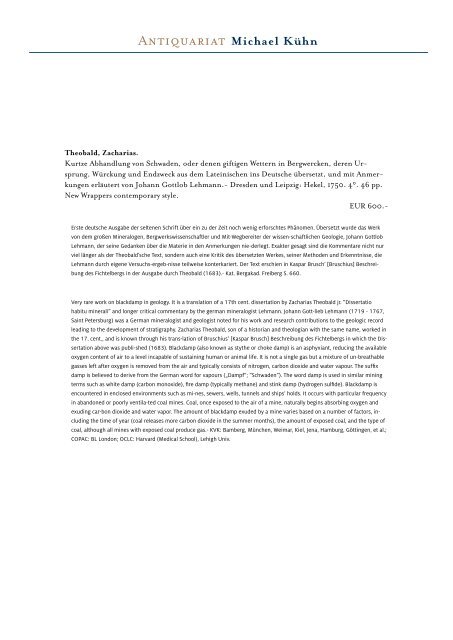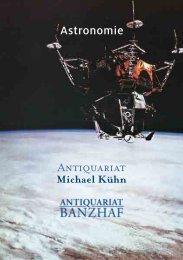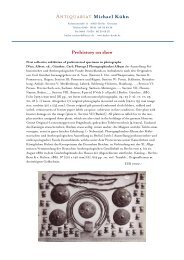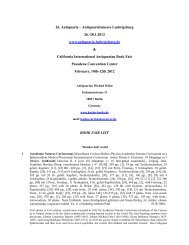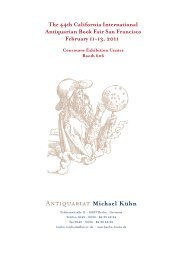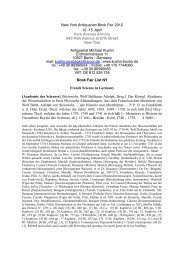Dezember 2012 - Antiquariat - Michael Kühn
Dezember 2012 - Antiquariat - Michael Kühn
Dezember 2012 - Antiquariat - Michael Kühn
Sie wollen auch ein ePaper? Erhöhen Sie die Reichweite Ihrer Titel.
YUMPU macht aus Druck-PDFs automatisch weboptimierte ePaper, die Google liebt.
<strong>Antiquariat</strong> <strong>Michael</strong> <strong>Kühn</strong><br />
Erdmannstraße 11 · 10827 Berlin · Germany<br />
Telefon 0049 · (0)30 · 86 39 69 34<br />
Fax 0049 · (0)30 · 86 39 69 55<br />
kuehn.rarebooks@arcor.de · www.kuehn-books.de<br />
Theobald, Zacharias.<br />
Kurtze Abhandlung von Schwaden, oder denen giftigen Wettern in Bergwercken, deren Ursprung,<br />
Würckung und Endzweck aus dem Lateinischen ins Deutsche übersetzt, und mit Anmerkungen<br />
erläutert von Johann Gottlob Lehmann.- Dresden und Leipzig: Hekel, 1750. 4°. 46 pp.<br />
New Wrappers contemporary style.<br />
EUR 600.-<br />
Erste deutsche Ausgabe der seltenen Schrift über ein zu der Zeit noch wenig erforschtes Phänomen. Übersetzt wurde das Werk<br />
von dem großen Mineralogen, Bergwerkswissenschaftler und Mit-Wegbereiter der wissen-schaftlichen Geologie, Johann Gottlob<br />
Lehmann, der seine Gedanken über die Materie in den Anmerkungen nie-derlegt. Exakter gesagt sind die Kommentare nicht nur<br />
viel länger als der Theobald’sche Text, sondern auch eine Kritik des übersetzten Werkes, seiner Methoden und Erkenntnisse, die<br />
Lehmann durch eigene Versuchs-ergeb-nisse teilweise konterkariert. Der Text erschien in Kaspar Brusch’ [Bruschius] Beschreibung<br />
des Fichtelbergs in der Ausgabe durch Theobald (1683).- Kat. Bergakad. Freiberg S. 660.<br />
Very rare work on blackdamp in geology. It is a translation of a 17th cent. dissertation by Zacharias Theobald jr. “Dissertatio<br />
habitu minerali” and longer critical commentary by the german mineralogist Lehmann. Johann Gott-lieb Lehmann (1719 - 1767,<br />
Saint Petersburg) was a German mineralogist and geologist noted for his work and research contributions to the geologic record<br />
leading to the development of stratigraphy. Zacharias Theobald, son of a historian and theologian with the same name, worked in<br />
the 17. cent., and is known through his trans-lation of Bruschius’ [Kaspar Brusch] Beschreibung des Fichtelbergs in which the Dissertation<br />
above was publi-shed (1683). Blackdamp (also known as stythe or choke damp) is an asphyxiant, reducing the available<br />
oxygen content of air to a level incapable of sustaining human or animal life. It is not a single gas but a mixture of un-breathable<br />
gasses left after oxygen is removed from the air and typically consists of nitrogen, carbon dioxide and water vapour. The suffix<br />
damp is believed to derive from the German word for vapours („Dampf“; “Schwaden”). The word damp is used in similar mining<br />
terms such as white damp (carbon monoxide), fire damp (typically methane) and stink damp (hydrogen sulfide). Blackdamp is<br />
encountered in enclosed environments such as mi-nes, sewers, wells, tunnels and ships‘ holds. It occurs with particular frequency<br />
in abandoned or poorly ventila-ted coal mines. Coal, once exposed to the air of a mine, naturally begins absorbing oxygen and<br />
exuding car-bon dioxide and water vapor. The amount of blackdamp exuded by a mine varies based on a number of factors, including<br />
the time of year (coal releases more carbon dioxide in the summer months), the amount of exposed coal, and the type of<br />
coal, although all mines with exposed coal produce gas.- KVK: Bamberg, München, Weimar, Kiel, Jena, Hamburg, Göttingen, et al.;<br />
COPAC: BL London; OCLC: Harvard (Medical School), Lehigh Univ.


